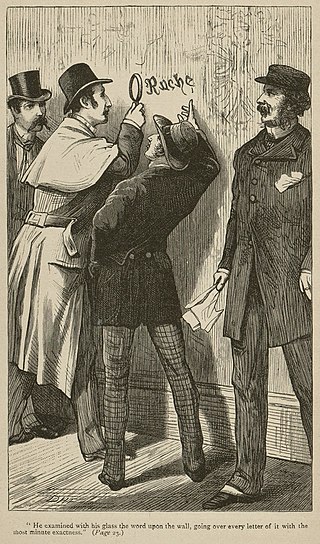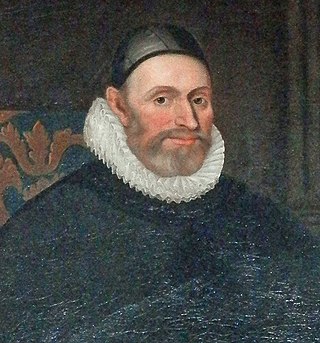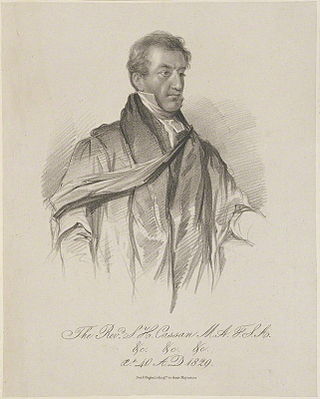Barnabe Rich was an English author and soldier, and a distant relative of Lord Chancellor Rich.

The term "Cavalier" was first used by Roundheads as a term of abuse for the wealthier royalist supporters of King Charles I and his son Charles II of England during the English Civil War, the Interregnum, and the Restoration. It was later adopted by the Royalists themselves. Although it referred originally to political and social attitudes and behaviour, of which clothing was a very small part, it has subsequently become strongly identified with the fashionable clothing of the court at the time. Prince Rupert, commander of much of Charles I's cavalry, is often considered to be an archetypal Cavalier.

Jacob Bryant (1715–1804) was an English scholar and mythographer, who has been described as "the outstanding figure among the mythagogues who flourished in the late eighteenth and early nineteenth centuries."
A Tulchan was in Scotland a man appointed as bishop after the Reformation, who was a bishop in name only and whose revenue was drawn by his patron. The term originally referred to a calfskin stuffed with straw and presented to a cow, as if living, to induce her to give milk. The epithet Tulchan applied to the bishops is usually ascribed to the reformer and collector of Scottish proverbs David Fergusson.

A red herring is something that misleads or distracts from a relevant or important question. It may be either a logical fallacy or a literary device that leads readers or audiences toward a false conclusion. A red herring may be used intentionally, as in mystery fiction or as part of rhetorical strategies, or may be used in argumentation inadvertently.

The Witch of Edmonton is an English Jacobean play, written by William Rowley, Thomas Dekker and John Ford in 1621.

The Merry Devil of Edmonton is an Elizabethan-era stage play; a comedy about a magician, Peter Fabell, nicknamed the Merry Devil. It was at one point attributed to William Shakespeare, but is now considered part of the Shakespeare Apocrypha.

William Guild (1586–1657) was a Scottish minister, academic and theological writer.

Philip Ayres (1638–1712), the author of numerous books and pamphlets, flourished in the latter part of the seventeenth century; was born at Cottingham, and educated at Westminster, and St John's College, Oxford. He became tutor in the family of Montague Garrard Drake, of Agmondesham, Bucks, and lived in the family till his death on 1 December 1712. His chief work is his Lyric poems made in imitation of the Italians, 1687, a collection of original pieces and translations. One copy of verses is addressed to "his honoured friend" John Dryden.
Thomas Brewer was an English writer, of whose life no details are known.
Antony Brewer was a dramatist, author of The Love Sick King, to whom a number of other works have been attributed.
Thomas Edwards (1699–1757) was an English critic and poet, best known for a controversy with William Warburton, over the latter's editing of Shakespeare.
Sir Henry Fanshawe (1569–1616) was a Member of the English Parliament who held the office of Remembrancer of the Exchequer.

The spelling of William Shakespeare's name has varied over time. It was not consistently spelled any single way during his lifetime, in manuscript or in printed form. After his death the name was spelled variously by editors of his work, and the spelling was not fixed until well into the 20th century.
Lording Barry (1580–1629) was a 17th-century English dramatist and pirate.
Cupid's Whirligig, by Edward Sharpham (1576-1608), is a city comedy set in London about a husband that suspects his wife of having affairs with other men and is consumed with irrational jealousy. It was first published in quarto in 1607, entered in the Stationer's Register with the name "A Comedie called Cupids Whirlegigge." It was performed that year by the Children of the King's Revels in the Whitefriars Theatre where Ben Jonson's Epicene was also said to have been performed.
Thomas Savage of Rufford, Lancashire, was a member of the Worshipful Company of Goldsmiths and one of the ten seacoal-meters in London. Together with William Leveson, he was one of two trustees used by the original shareholders of the Globe Theatre in the allocation of their shares in 1599. He was an associate of the actor and editor of the First Folio, John Heminges, and of John Jackson, both of whom were Shakespeare's trustees in the purchase of the Blackfriars Gatehouse. Savage amassed a considerable fortune, at the time of his death owning five houses in London and an inn called the George.

Martin Davy (1763–1839) was an English physician and academic, Master of Caius College, Cambridge from 1803. In later life he was also a cleric.

Stephen Hyde Cassan (1789–1841) was an English Anglican priest and ecclesiastical biographer.
Jacob Ilive was an English type-founder, printer and author. He was a religious radical, who developed neognostic views based on deism. He spent time in prison, convicted of blasphemy.









